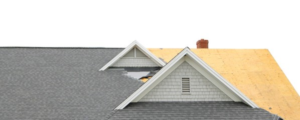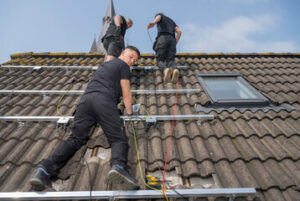The roof is the top covering of a structure, protecting it from rain, snow, sunlight, and temperature extremes. West Chester Roofing can be constructed in a wide variety of materials.

Metal roofs, for example, last longer than asphalt shingles and usually recoup more of their installation cost at home resale. Trim at the eaves protects the roofing panels from water back-up and helps to prevent leaks from ice dams.
Metal roofing is available in various materials including steel (galvanized, galvalume or weathering), aluminum and copper. It can be formed to imitate the look of shingles, slate, or clay roofs and comes in both flat and vertical seam styles. It also comes in many colors and coatings. It can be coated to protect against rust, or to give it the appearance of wood, tile, asphalt shingles or even concrete.
Metal roofs provide a durable and energy-efficient alternative to other roofing materials. They can withstand high wind speeds and impact from hail better than asphalt shingle roofs. They also tend to last longer than shingle roofs and are highly resistant to fire. They’re often less expensive to maintain than shingle roofs and add value to your home.
Most metal roofing is installed over a plywood sheathing and is adhered with the recommended underlayment. A quality underlayment prevents water leaks and is designed to flex with the metal. It’s important that the installer use a waterproofing underlayment that is designed to be used with metal roofing and that it complies with the local building codes.
Like any roofing material, metal roofs can get hot in the sun. However, most formed metal roofing panels have a built-in thermal break to insulate against the transfer of heat from the metal to the roof deck. This thermal break reduces the amount of heat that passes through the underlayment, which in turn cuts down on heating and cooling costs. In addition, if a metal roof is properly coated and maintained, it can reflect solar heat back into the atmosphere.
A metal roof is an excellent choice for people living in areas with heavy snowfall. Unlike a traditional shingle roof, metal roofs won’t hold onto snow and can be easily cleared with snow removal tools. Some metal roofs may be equipped with snow guards to prevent avalanches that can damage decks, shrubs, cars and people.
When you choose a metal roof, it’s important to understand the difference between galvanized and non-galvanized metal. Non-galvanized metals will rust faster than galvanized metals and need to be repainted or coated with a weathering coating. It’s also important to remember that a metal roof can be placed over an existing shingle roof, and this is often a cost-effective way to upgrade your roof.
Asphalt shingles are the most popular roofing option for homeowners. They provide a good balance between affordability, durability, and aesthetics. They are available in a wide range of colors and styles, making them suitable for many different architectural designs. Additionally, they are easy to install and require little maintenance.
Most roofing contractors will recommend fiberglass asphalt shingles, as these are more durable than their counterparts and have a longer lifespan. If you are looking for a more customized look, however, you might want to consider architectural or dimensional shingles. These are available in a variety of colors and granule options, and can be designed to resemble the look of other types of roofing, such as wood or slate.
While they are less durable than metal roofs, asphalt shingles can still stand up to harsh weather conditions. They are also resistant to fire and wind, and can comply with most building code requirements. Asphalt shingles are also easy to repair, which is important for those living in storm-prone areas.
Another advantage of asphalt shingles is that they are not as heavy as other roofing materials. This means that they can be installed on most existing homes without the need to add structural support. This is not always the case for other types of roofing, which may require significant structural changes.
Choosing the right asphalt shingle color can make a big difference in your home’s curb appeal. It is essential to find a shade that will complement the rest of your home’s exterior and blend in with the surrounding neighborhood. The good news is that there are now a number of online tools that allow you to test out different shades before committing to one.
In addition to their attractive appearance, asphalt shingles are known for their energy efficiency. Some of them are designed to reflect a large percentage of the sun’s infrared radiation, which can help reduce your heating and cooling costs. This is especially beneficial in warmer climates, where the cost of electricity can be much higher.
Shingles are a familiar sight on many roofs as they’re one of the most common roofing materials. They’re affordable and durable and offer homeowners a variety of aesthetics and color options to choose from. However, it’s important to note that shingles are only part of the system that protects your roof. Other components like the underlayment, flashing, and shingle type work together to shed water and prevent it from entering your home.
The shingles themselves can be made from several different materials, including wood, clay, slate, and composite. Each offers its own benefits and drawbacks. For example, wood shingles add a rustic, cottage-esque look to homes and are available in a wide range of colors and textures. They’re also quite resilient against weather, but aren’t suited to persistently rainy or damp areas. Slate shingles are another time-honored option that’s popular for homes with stately or historic architecture. They’re durable and resistant, and can last for a century or more when well-maintained. However, they’re heavy, and require a highly skilled and experienced tradesperson to install.
Asphalt shingles are the most commonly used shingle type. They’re made from an end-product of oil refining and are infused with a small amount of mineral powder to help boost their durability and weather resistance. The granules also provide UV protection for the asphalt and add visual appeal to your roof. It’s also worth noting that asphalt shingles aren’t the most energy-efficient choice, especially when compared to other roofing types.
Regardless of the shingle material you choose, it’s important to consider your budget and the aesthetic you’re looking for. Most shingle materials perform equally well, so the decision is largely down to personal preference and style. A roofing professional can help you compare your options and decide what’s best for your home. They’ll also take into account any specific needs you may have, like the ability to handle snow or moisture, or the need for certain fire-resistant qualities. Choosing the right shingle roof will ultimately save you money and keep your home safe for decades to come.
While flat roofs are not as common as sloped roofs, they offer a variety of benefits for businesses and homes. These include reducing heat absorption, creating additional living space and being suitable for solar panel installation. However, there are some considerations that should be taken into account before choosing this type of roofing.
Because of their low profile, flat roofs must be constructed from different materials than shingles or sloped roofing. They also need to be waterproof and durable. There are several types of flat roofing materials that can be used, including tar and gravel, EPDM synthetic rubber, PVC plastic and TPO (thermoplastic polyolefin). Built-up roofing is also a popular choice because of its durability and affordability.
One of the main problems with flat roofs is that water drains more slowly than on a sloped roof, so it can build up and cause leaks. This is why it is important to have regular inspections from a professional to catch any potential problems early on. Another issue is that because the roof is not sloping, it is easier for debris to collect on the surface. This can include twigs, leaves, dirt and other waste, which may lead to the drains becoming clogged.
The best way to prevent this from happening is to have a regular maintenance schedule and ensure that the drains are free of debris. However, even with these precautions, it is possible that a flat roof will leak at some point. This is because the waterproof membrane can become damaged due to age or weathering.
If this happens, it is crucial to call a roofing specialist right away. They will be able to repair the leaks and restore the watertight properties of the roof.
Although it is true that flat roofs are not as aesthetically pleasing as sloped roofs, they are becoming more and more popular for businesses and modern homes. This is because they provide a functional and unique design option, as well as adding value to the property. As technology advances, it is likely that flat roofs will be more accepted among homeowners, too.

